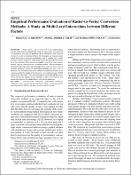Options
Empirical performance evaluation of raster-to-vector conversion methods: A study on multi-level interactions between different factors
Journal
Open Access
IEICE Transactions on Information and Systems
Date Issued
2011
Author(s)
Al-Khaffaf H.S.M.
Talib A.Z.
Salam R.A.
DOI
10.1587/transinf.E94.D.1278
Abstract
Many factors, such as noise level in the original image and the noise-removal methods that clean the image prior to performing a vectorization, may play an important role in affecting the line detection of raster-to-vector conversion methods. In this paper, we propose an empirical performance evaluation methodology that is coupled with a robust statistical analysis method to study many factors that may affect the quality of line detection. Three factors are studied: noise level, noise-removal method, and the raster-to-vector conversion method. Eleven mechanical engineering drawings, three salt-and-pepper noise levels, six noise-removal methods, and three commercial vectorization methods were used in the experiment. The Vector Recovery Index (VRI) of the detected vectors was the criterion used for the quality of line detection. A repeated measure ANOVA analyzed the VRI scores. The statistical analysis shows that all the studied factors affected the quality of line detection. It also shows that two-way interactions between the studied factors affected line detection. Copyright � 2011 The Institute of Electronics, Information and Communication Engineers.
File(s)
Loading...
Name
Empirical performance evaluation of raster-to-vector conversion methods; A study on multi-level interactions between different factors.pdf
Size
403.72 KB
Format
Adobe PDF
Checksum
(MD5):15b88f211f84a68a90a906392db078ec